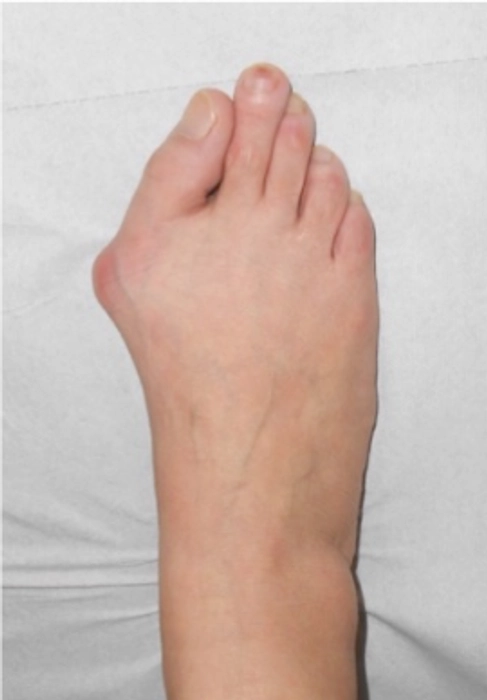Introduction
Hallux Valgus, commonly known as a bunion, is a deformity of the big toe characterized by the outward deviation of the metatarsophalangeal joint. This condition can cause pain, discomfort, and difficulty wearing shoes. At Dhyan Healthcare, we are committed to helping you understand and manage Hallux Valgus effectively.
What Causes Hallux Valgus?
Hallux Valgus can result from various factors, including:
- Genetics: Inherited foot structure that predisposes individuals to bunions.
- Footwear: Tight, narrow shoes that compress the toes.
- Foot Type: Flat feet or low arches can increase the risk of bunions.
- Foot Injuries: Trauma to the foot or toe.
- Medical Conditions: Rheumatoid arthritis or other inflammatory joint diseases.
Symptoms of Hallux Valgus
- Bump on the Side of the Foot: The hallmark sign of a bunion.
- Pain and Discomfort: Particularly when wearing shoes or walking.
- Swelling and Redness: Around the affected joint.
- Limited Movement: Difficulty bending or straightening the big toe.
- Corns and Calluses: From friction and pressure against shoes.
Diagnosis
Accurate diagnosis involves a thorough examination by a healthcare professional, which may include:
- Physical Examination: Assessing the appearance of the foot and range of motion of the big toe.
- Foot Analysis: Evaluating foot structure and alignment.
- X-rays: To determine the severity of the deformity and assess any joint damage.
Treatment Options
Managing Hallux Valgus focuses on relieving symptoms, slowing the progression of the deformity, and improving foot function. Here’s a comprehensive treatment plan:
-
Non-Surgical Treatments
- Footwear Modifications
- Prescription: Wear shoes with a wide toe box and low heels.
- Benefits: Reduces pressure on the bunion and alleviates pain.
- Toe Spacers
- Prescription: Soft pads or spacers placed between the toes.
- Benefits: Helps realign the toes and reduces friction.
- Orthotic Devices
- Prescription: Custom-made orthotic inserts or arch supports.
- Benefits: Provides support and corrects foot mechanics.
- Toe Exercises
- Prescription: Stretching and strengthening exercises for the toes and feet.
- Examples:
- Toe Flexion and Extension: Flexing and extending the toes against resistance.
- Toe Squeezes: Gripping a small object with the toes to strengthen foot muscles.
- Benefits: Improves flexibility, strength, and alignment.
- Footwear Modifications
-
Medications
- Prescription: Over-the-counter pain relievers like ibuprofen or acetaminophen.
- Benefits: Alleviates pain and reduces inflammation.
-
Padding and Taping
- Prescription: Use of padding or tape to cushion the bunion and reduce friction.
- Benefits: Provides temporary relief and prevents further irritation.
-
Surgical Intervention
- Prescription: Surgery may be necessary if non-surgical treatments are ineffective or the deformity is severe.
- Examples:
- Bunionectomy: Removal of the bony prominence and realignment of the toe joint.
- Osteotomy: Cutting and realigning the bones of the foot.
- Arthrodesis: Fusion of the toe joint.
- Benefits: Provides long-term correction of the deformity and relief from symptoms.
Lifestyle and Home Remedies
In addition to professional treatment, several home remedies and lifestyle adjustments can help manage Hallux Valgus:
- Maintain a Healthy Weight: Reduces pressure on the feet.
- Choose Proper Footwear: Wear supportive shoes with a wide toe box.
- Avoid High Heels: High-heeled shoes can exacerbate the condition.
- Use Protective Padding: Apply moleskin or gel pads to cushion the bunion.
- Toe Stretching Exercises: Helps maintain flexibility and prevent stiffness.
When to See a Doctor
If you experience persistent pain, swelling, or difficulty walking due to a bunion, it’s crucial to seek medical attention. Early diagnosis and treatment can prevent complications and improve your quality of life.
Conclusion
Managing Hallux Valgus effectively requires a combination of professional medical treatment, supportive therapies, and proactive self-care. At Dhyan Healthcare, we are dedicated to providing comprehensive care tailored to your individual needs. If you suspect you have Hallux Valgus, don’t hesitate to contact us for a detailed evaluation and personalized treatment plan.
For more information or to schedule an appointment, visit our website or call our clinic. Your journey to pain-free feet and improved mobility starts here!


